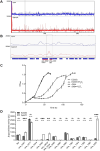PerR functions as a redox-sensing transcription factor regulating metal homeostasis in the thermoacidophilic archaeon Saccharolobus islandicus REY15A
- PMID: 39727184
- PMCID: PMC11724291
- DOI: 10.1093/nar/gkae1263
PerR functions as a redox-sensing transcription factor regulating metal homeostasis in the thermoacidophilic archaeon Saccharolobus islandicus REY15A
Abstract
Thermoacidophilic archaea thrive in environments with high temperatures and low pH where cells are prone to severe oxidative stress due to elevated levels of reactive oxygen species (ROS). While the oxidative stress responses have been extensively studied in bacteria and eukaryotes, the mechanisms in archaea remain largely unexplored. Here, using a multidisciplinary approach, we reveal that SisPerR, the homolog of bacterial PerR in Saccharolobus islandicus REY15A, is responsible for ROS response of transcriptional regulation. We show that with H2O2 treatment and sisperR deletion, expression of genes encoding proteins predicted to be involved in cellular metal ion homeostasis regulation, Dps, NirD, VIT1/CCC1 and MntH, is significantly upregulated, while expression of ROS-scavenging enzymes remains unaffected. Conversely, the expression of these genes is repressed when SisPerR is overexpressed. Notably, the genes coding for Dps, NirD and MntH are direct targets of SisPerR. Moreover, we identified three novel residues critical for ferrous ion binding and one novel residue for zinc ion binding. In summary, this study has established that SisPerR is a repressive redox-sensing transcription factor regulating intracellular metal ion homeostasis in Sa. islandicus for oxidative stress defense. These findings have shed new light on our understanding of microbial adaptation to extreme environmental conditions.
© The Author(s) 2024. Published by Oxford University Press on behalf of Nucleic Acids Research.
Figures








References
-
- Imlay J.A. Pathways of oxidative damage. Annu. Rev. Microbiol. 2003; 57:395–418. - PubMed
-
- Holmström K.M., Finkel T.. Cellular mechanisms and physiological consequences of redox-dependent signalling. Nat. Rev. Mol. Cell Biol. 2014; 15:411–421. - PubMed
-
- Sies H., Belousov V.V., Chandel N.S., Davies M.J., Jones D.P., Mann G.E., Murphy M.P., Yamamoto M., Winterbourn C.. Defining roles of specific reactive oxygen species (ROS) in cell biology and physiology. Nat. Rev. Mol. Cell Biol. 2022; 23:499–515. - PubMed
-
- Johnson L.A., Hug L.A.. Distribution of reactive oxygen species defense mechanisms across domain bacteria. Free Radical Biol. Med. 2019; 140:93–102. - PubMed
MeSH terms
Substances
Grants and funding
LinkOut - more resources
Full Text Sources
Molecular Biology Databases

